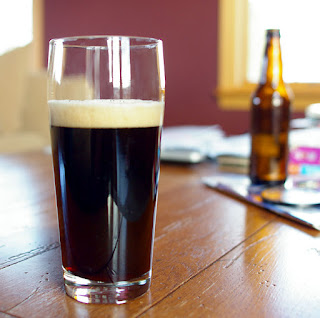 This is the second tasting from my aged homebrew "collection". This time, I have a Scottish Ale (a 60 Schilling or 60/-) named #38. This was brewed a couple of years back as a birthday gift for my dad (no, not his 38th birthday). He read the description of the style and it intrigued him, so I surprised him with a case of it (I kept a case for myself...). If I recall correctly, this was my last full 5 gallon batch. Even though I was doing partial mashes, I wanted to minimize the amount of extract I had to use, so I switched to smaller 3.5ish gallon batches on all subsequent brews.
This is the second tasting from my aged homebrew "collection". This time, I have a Scottish Ale (a 60 Schilling or 60/-) named #38. This was brewed a couple of years back as a birthday gift for my dad (no, not his 38th birthday). He read the description of the style and it intrigued him, so I surprised him with a case of it (I kept a case for myself...). If I recall correctly, this was my last full 5 gallon batch. Even though I was doing partial mashes, I wanted to minimize the amount of extract I had to use, so I switched to smaller 3.5ish gallon batches on all subsequent brews. I remember thinking that this beer turned out pretty good - certainly seemed to style - light, easy drinking, malt-forward, dark copper-colored, some fruity esters. Over two years later, it has held up very well and I think it is still a nice example of the style, though perhaps a little too light on the hops. Shortly after I discovered my forgotten stash, I learned that my dad still has some bottles of this left, so I was thinking it might be fun to enter it in a competition or two and see how it stacks up.
Appearance - Pours a dark copper, almost brown, with a thin white ring of bubbles. Clarity is excellent.
Aroma - Very mild aroma. What little aroma there is is definitely all malt - no hop aroma whatsoever. I pick up some toffee and light caramel. Maybe some oxidized quality as well.
Taste - Follows aroma. Very mild, almost entirely malt - toffee, caramel, a hint of roast. Definitely some oxidized flavors as well. A little hop spiciness. Bitterness is barely there - just a touch at the end. Finishes fairly dry. Some sweetness, but not at all like the aged Irish Red I reviewed a little while back. No signs of infection.
Mouthfeel - low carbonation, almost still. On the thin side. Definitely an easy drinker, though a little more body would make it better.
Overall - Yet another successfully aged beer. This beer is very mild, but tastes good. And at 3.4% ABV, it makes for a nice session beer. I could definitely drink several of these, though I think I would want to move onto something with more flavor. This kind of reminds me of a Bass or a Smithwicks - it has that same level of mildness and thin body. So far, I'm enjoying this stroll down beer memory lane. I can't wait to try the remaining aged brews!
#38 Scottish Ale (60/-)
Partial Mash
OG 1.040
FG 1.014
IBUs: 23
SRM: 16
17% Maris Otter
17% Crystal 40L
7.5% Crystal 120L
7.5% Honey Malt
7.5% Munich Malt
2% Chocolate Malt
42.5% Extra Light DME
East Kent Goldings hops @ 60min
WLP004 Irish Ale yeast




